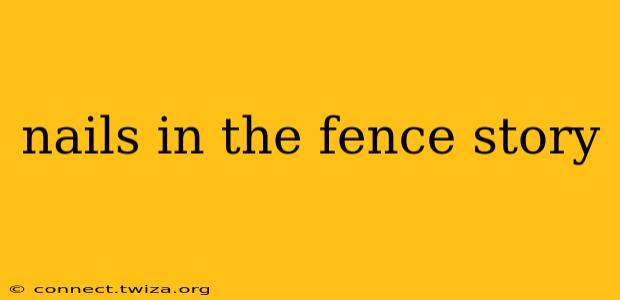The story of the nails in the fence is a powerful parable about the destructive nature of anger and the healing power of forgiveness. It's a simple tale, yet its message resonates deeply with people of all ages and backgrounds. While the exact origin of the story is unclear, its enduring popularity highlights its timeless relevance. This post will explore the story, its meaning, and how we can apply its lessons to our own lives.
What is the Nails in the Fence Story?
The story typically goes something like this: A father, frustrated and angry with his teenage son, tells the boy to hammer nails into their fence post every time he loses his temper. Initially, the fence becomes riddled with nails, a visual representation of the boy's uncontrolled anger. However, as the days and weeks pass, the boy begins to make a conscious effort to control his anger. Each day that he manages to keep his temper, he removes a nail.
Finally, the day arrives when the fence is clear of nails. The father then takes his son to the fence and points to the holes that remain. He explains that while the nails are gone, the scars remain – a poignant reminder of the damage caused by anger, even after it has subsided. The story concludes with a lesson about the lasting impact of negative emotions and the importance of managing our anger effectively.
Why is the Nails in the Fence Story So Popular?
The story's enduring appeal lies in its simplicity and powerful message. It's a relatable narrative, as many people struggle with managing their anger. The visual metaphor of the nails in the fence makes the consequences of anger tangible and easily understood. The story provides a clear, memorable illustration of how our actions, even seemingly small ones, have lasting repercussions.
What are the Key Lessons of the Nails in the Fence Story?
The story offers several key takeaways:
- The Long-Term Effects of Anger: The holes in the fence represent the lasting impact of anger. Even after we apologize or try to make amends, the damage often remains. This underscores the importance of proactive anger management.
- The Power of Self-Control: The boy's ability to control his anger demonstrates the transformative power of self-discipline. It highlights that anger isn't an uncontrollable force, but a behavior that can be modified with conscious effort.
- The Importance of Forgiveness: Although the story focuses on self-control, it also subtly suggests the importance of forgiveness—both for oneself and others. The father's act of using the story as a teaching moment, rather than punishment, demonstrates a form of forgiveness.
- The Value of Visual Representation: The physical act of hammering nails and removing them creates a powerful visual learning experience that makes the message far more impactful than abstract lectures.
What are some ways to manage anger effectively?
The story inspires reflection on anger management techniques. Here are a few strategies:
- Identify Your Triggers: Understanding what situations or people tend to trigger your anger is crucial in managing it effectively.
- Develop Coping Mechanisms: Learn healthy ways to cope with anger, such as deep breathing exercises, meditation, or physical activity.
- Communicate Effectively: Learning to express your feelings in a calm and assertive way can prevent anger from escalating.
- Seek Professional Help: If anger is significantly impacting your life, consider seeking help from a therapist or counselor.
How can I apply the Nails in the Fence story to my life?
The story serves as a powerful reminder to be mindful of our emotions and their consequences. Consider adopting a similar visual representation in your own life – perhaps a journal where you record instances of anger and reflect on how you could handle them differently.
The nails in the fence story, though simple, offers profound wisdom about the destructive power of anger and the rewarding journey of self-control and forgiveness. By understanding its message and applying its lessons, we can build healthier relationships and cultivate a more peaceful and fulfilling life.
